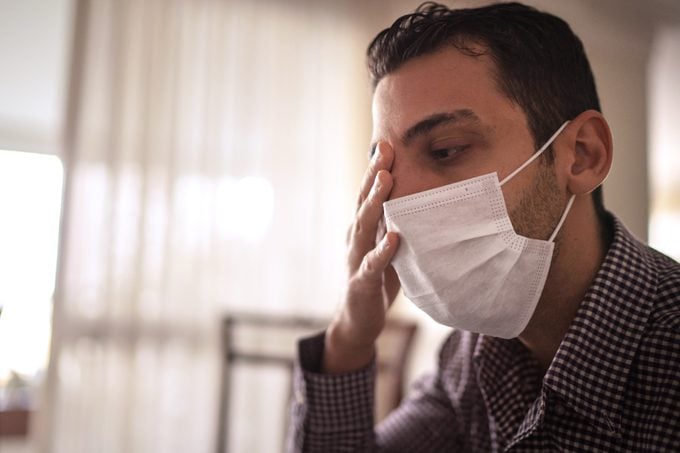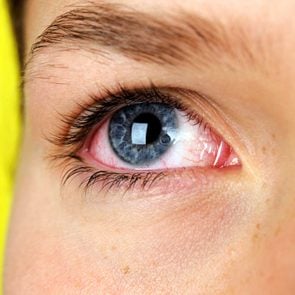Yes, Your Face Mask Can Irritate Your Eyes: 6 Solutions from Eye Specialists
Updated: Apr. 29, 2021
Masks are an essential ingredient in the fight against Covid-19's spread, but our eyes are paying a price.
Our editors and experts handpick every product we feature. We may earn a commission from your purchases.
Masks and your eyes
The Centers for Disease Control and Prevention (CDC) recommends masks to help prevent the spread of Covid-19. But it’s easy to make mask-wearing mistakes—like exposing your nose or keeping your face covering too loose—especially if you have breathing issues, skin irritation, or other complicating factors.
Now, eye doctors are helping patients recover from a variety of eye problems resulting from those mask-wearing mistakes.
Early on, some mask wearers complained of foggy glasses while wearing a mask. That’s an annoying problem that can become dangerous in certain situations like while operating machinery or treating patients. But eye experts are seeing a rise in other problems, including:
-
Bacterial eyelid infections
-
Corneal damage (abrasions, scratches)
-
Allergy-like irritation from detergents on the masks
-
Styes from clogged tear ducts
Warm air blowing up from breathing in a mask is the cause of many of these issues, says Jonathan Wolfe, an optometrist in Ardsley, New York. “Increased airflow around the eyes [causes] our natural ocular lubrication to evaporate and dry out faster than usual, leading to damaged corneal and conjunctiva tissue,” Wolfe says. “This is more anecdotal, but many eye care providers are noticing an uptick in eyelid infections after Covid-19. It’s tough to know the exact cause. It may be because of the warm exhaled air coming up underneath the mask to the eyes. Or it may be a widespread increase in general stress and anxiety causing this to happen.”
An article published in September 2020 in Ophthalmology and Therapy looked at the potential health impacts that masks can have on the eyes. The researchers say that eye practitioners report an “increase in ocular irritation and dryness among regular mask users.”
Eye doctors have some tips to solve those irritating, and potentially more serious, eye concerns.
Create a better seal
The reason hot air is bothering your eyes is that your mask isn’t fitting properly on the bridge of your nose. Some people are making intentional gaps by bending the wire to allow air to come in and out, but that hot air has to go somewhere; namely: into your eyes.
“A poorly fitting mask is one of the major causes of mask-related eye issues,” says Margaret Liu, MD, an ophthalmologist and founder of the San Francisco Eye Institute with the Pacific Vision Foundation. “When a mask sits loosely against the face, the exhaled air from one’s mouth blows over the surface of the eye, resulting in an increased risk of foggy lenses and mask-associated dry eyes.”
Dr. Liu recommends taking the following steps to “direct airflow downwards.”
-
Use the adjustable mask wire to mold the mask to your face and create a tight seal around the bridge of your nose.
-
Seal further with a strip of tape across the mask onto your cheeks and nose to reinforce the seal. (She recommends paper tape to minimize skin irritation.)
-
If you wear glasses, use fogginess as a guide of how well you’ve made a seal: You shouldn’t have any fogging with a proper seal.

Ensure a proper fabric and fit
Your mask should never touch your eyes. Even if you’re exercising, the mask should remain in place. (Consider a more exercise-friendly mask option if yours isn’t holding up well during your sweat sessions.)
Mask-related cornea scratches and irritation could be coming from putting on and removing your mask, “especially the hard cloth material,” Yuna Rapoport, MD, an ophthalmologist in New York City. Some patients have a “mini scratch from the fluff from surgical masks.”
It’s important to choose a fabric that can’t scratch your eyes if you hastily put on or remove the mask. Double-layer cotton fabrics are some of the best to use for DIY masks, according to a study from Duke University published in 2020 in Science Advances. If the material is stiff or rough, wash it a few times to help soften it.
Be careful not to touch your eyes with the mask when you take it on and off.
Give your eyes a pick-me-up
Styes, dry eye, and irritation can be treated with some over-the-counter options. Our eye experts recommended:
-
Lubricating drops to replace the natural liquid in your eyes
-
Lid scrubs, such as Ocusoft, to help relieve eye irritation
-
A warm compress placed over the eyes to prevent styes
-
Anti-fogging spray—applied multiple times per day or week—for people who wear glasses
“There is a newer coating that came on the market as a result of Covid, and it is something that lens labs would apply to the back surface of your glasses,” Wolfe says of anti-fogging sprays. “This coating can be left alone once applied. No need to condition or reapply it.”
Lubricating drops, in particular, are a popular remedy for a variety of issues and potential problems. “To alleviate mask-associated dry eyes, in addition to a properly fitted mask, I recommend using artificial tears,” Dr. Liu says. “Artificial tears moisturize eyes in a way similar to natural tears thereby providing relief from dry eye symptoms such as grittiness, redness, and even blurry vision.” To start, here are the best eye drops for dry eyes.
Look into vision correction surgery to replace glasses
If you’ve been thinking about vision correction surgery, wearing a mask and glasses together might help you make your decision.
Dr. Rapoport has seen a 25 percent increase in LASIK requests since the pandemic started, “partly because of foggy glasses and partly because patients who had perhaps saved money for travel and entertainment now have extra funds to use.”
Even contact lens wearers are considering LASIK, as it can “decrease the risk for infection associated with contact lens wear,” she says.
Stop touching your face (and eyes)
Adjusting the placement of your mask is one thing. But touching your eyes—like, say, when they’re irritated by the hot air blowing up from your mask—is one of the worst things you can do. And not just in terms of Covid-19 prevention. It’s also bad for the health of your eyes.
A study published in April 2020 in The BMJ analyzed the use of face masks during the pandemic. Researchers found that “wearing a face mask makes the exhaled air go into the eyes. This generates an uncomfortable feeling and an impulse to touch your eyes. If your hands are contaminated, you are infecting yourself.”
The CDC continues to spread the message that you can infect yourself with Covid-19 by transmitting the virus from your hands to your own eyes, nose, or mouth. Be aware of keeping your hands away from your face.
Seek expert help in certain cases
It’s one thing to have a little eye irritation. But if you find yourself struggling for more than a few days, it may be time to see an eye doctor.
“I typically would have someone come by the office if, say, a lid infection hasn’t gone away on its own with warm compresses after two to three days,” Wolfe says. “Unless the issue arises very suddenly, or the symptoms are concerning and severe, there’s usually no harm in trying over-the-counter solutions for two to three days. With lid infections, in particular, if you wait much longer than that to seek proper treatment, it can become much more difficult to manage.”
As Dr. Rapoport points out, “The cornea has more nerve endings than anywhere in the body, so a little discomfort could mean that there is a stye, irritation, or scratch. Catching it early leads to quicker resolution of symptoms.”














